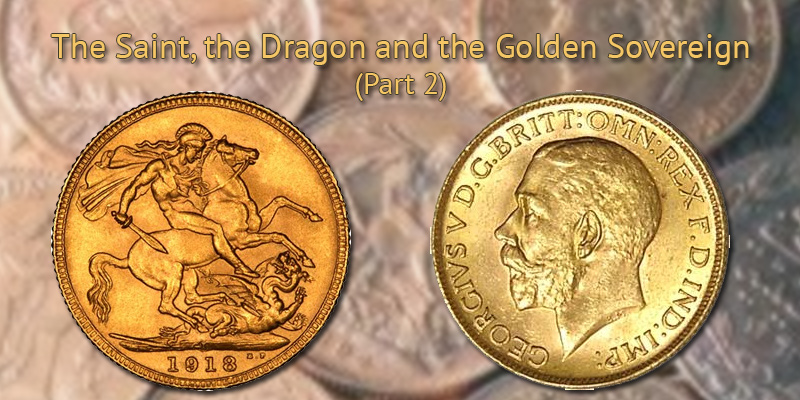The Saint, the Dragon and the Golden Sovereign (Part 2)
Published

In the great days of the British Empire - Sovereign coins were also issued in other countries of the Empire. Six mint shops issued local Sovereign coins, usually with the same or similar design of the British coins (which have no sign of mint), but sometimes with a different design:
There were three mint shops in Australia: from 1855 to 1870 in Sydney only, with no sign of mint. Later mint shops were opened in Melbourne (mint mark M), Sydney (S) and Perth (P, Only since -1899) and made their mark on the world of Sovereign until 1931. Between 1871 and 1887 models of a dragon and a protective shield were also minted. In the dragon models the mint sign M or S appear on the front side of the coin, under the head of Young Victoria
India (I) minted only one Sovereign in Bombay, in 1918.
 Canada (C) minted Sovereign coins in an Ottawa mint shop between 1908 and1919 (not all).
Canada (C) minted Sovereign coins in an Ottawa mint shop between 1908 and1919 (not all).
In South Africa (SA) Sovereign coins were minted in Pretoria between 1923 and1932.
Identifying the various mint shops was made according to the mint mark, which can usually be found at the base upon which the horse stands (George and the Dragon model) or under the shield (shield models).
There are other countries that issued Sovereign coins, but these took place in relatively recent years: Andorra, Gibraltar and the Isle of Man.
The connection to Israel
So what additional connection is there between the Sovereign coins and Israel? In the 19th century, with the emergence in world trade and the need to establish a uniform and acceptable international monetary system, gold was set as its basis. As being a superpower and world-embracing Empire with many colonies the Sovereign coins of the United Kingdom turned into reliable and prioritized currencies in many countries. Countries having their own currencies, such as France, Italy, Russia and Turkey, set their currency rates in relation to the British golden Sovereign. In Israel, Palestine at the time, no coins of a defined state entity were issued, and so people living there were forced to use foreign currencies to run commercial and economic life. The list of foreign currencies in the late 19th and early 20th centuries are mainly the Turkish Lira (naturally resulting from the fact of Ottoman rule at the time), but also French Francs (the name given to 20 Frank coins was "Napoleons"), Russian Rubles, Austrian Ducats, German Marks and British Sovereigns.
 In the small Jewish community, which consisted of about 20,000 residents in the 70s of the 19th century, many demographic, social and cultural changes arose not only as a result of growing interest of European countries regarding the religious and political background in Israel, but also as a result of Zionist awakening which was manifested in establishing new settlements, public and educational institutions. These changes were also manifested in the monetary field, when the demand for means of payment increased. Until the end of World War I, the date when the British introduced the Egyptian currency as a legal currency in Israel, the Jewish community had used all the aforementioned coins and in particular Sovereigns, Napoleons and of course the Turkish lira.
In the small Jewish community, which consisted of about 20,000 residents in the 70s of the 19th century, many demographic, social and cultural changes arose not only as a result of growing interest of European countries regarding the religious and political background in Israel, but also as a result of Zionist awakening which was manifested in establishing new settlements, public and educational institutions. These changes were also manifested in the monetary field, when the demand for means of payment increased. Until the end of World War I, the date when the British introduced the Egyptian currency as a legal currency in Israel, the Jewish community had used all the aforementioned coins and in particular Sovereigns, Napoleons and of course the Turkish lira.
Reich). She, too, was equipped with Sovereign gold coins hidden in her coat, soles of her shoes and belt.
How much is it worth?
We will conclude with a topic that interests many, especially those into whose hands such a treasure falls: What is the value of a Sovereign coin? The value of any coin in general, and naturally that of the Sovereign, is usually determined by the weight of the metal, or - if demanded - according to its collector value, that is, how much a buyer is willing to pay for it. The modern Sovereigns are made of 22 carat gold and their weight is 7.9881 gram. Therefore, the net gold weight of each of them is 0.2354 ounce. In the current market prices (May 2015) an ounce of gold is approximately sold for $1200, and therefore the value of the metal of each coin (BV - Bullion Value) is about $283.
There are, of course, exceptions where catalogs refer to a higher collector's value than the weight of gold. We will not discuss that here, but will refer interested collectors to this source.
This, in short, is the story of the Sovereign coin which began its way in Lod and Ashkelon, by telling the stories of knights and dragons. It was first minted at the end of the 15th century and continued its road in the first part of the 20th century, under the influence of the industrial revolution, with the figure of Saint George and the Dragon. It has spread throughout the British Empire and the whole world, and still continues to successfully act in the numismatic world up to this day.





